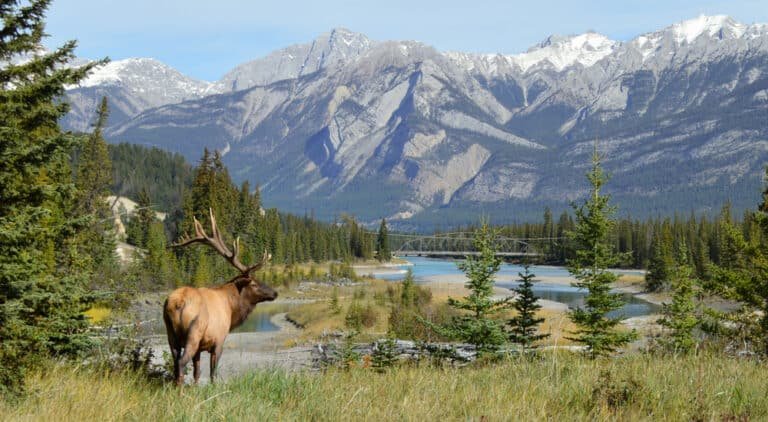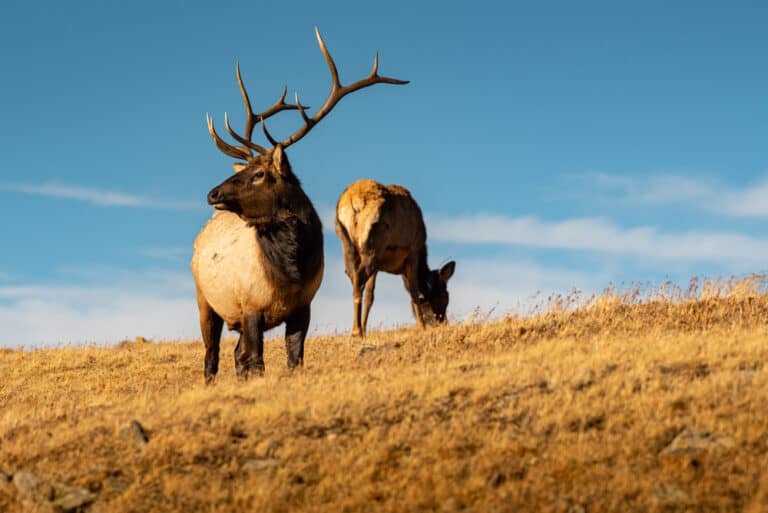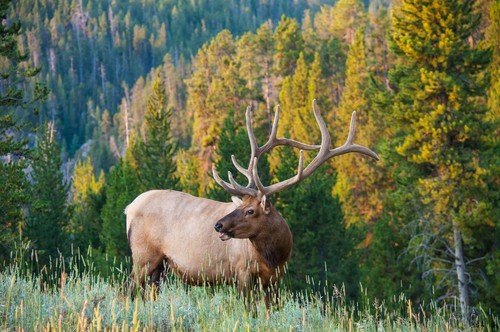Camouflage Tips for Elk Hunting – Finding The Best Fit
Elk hunting is a challenging and thrilling pursuit that requires stealth, skill, and effective camouflage. When blending in with the environment, camouflage is crucial in ensuring success.
Elk possess keen senses and are highly perceptive creatures. Their exceptional vision and ability to detect movement make them incredibly difficult to approach undetected.
Therefore, utilizing proper camouflage techniques becomes essential for increasing your chances of getting within shooting range. Camouflage serves as a hunter’s disguise, allowing them to blend seamlessly into the natural surroundings of an elk‘s habitat.
By breaking up the human silhouette and camouflaging one’s body and gear, hunters can avoid detection and close the distance between themselves and their prey. The ability to remain unseen by elk is fundamental for hunters looking to engage in ethical hunting practices while also ensuring their personal safety.
Overview of the key elements of effective camouflage
Understanding the key elements is paramount to achieving effective camouflage for elk hunting. Firstly, color is crucial; it should match or blend harmoniously with the natural tones in elk habitats such as forests or grasslands.
Browns, greens, grays, and earthy shades are commonly found in popular camouflage patterns designed specifically for hunting elusive game like Elk. Additionally, patterns should break up your outline effectively by incorporating shapes that mimic surrounding foliage or terrain features.
Another critical element is texture. The texture of your clothing or gear should resemble the textures found in nature near your hunting area.
For instance, if you’re hunting among pine trees where bark is prevalent on trunks and branches littered on the ground, selecting clothing with similar texture can greatly enhance your concealment potential. But most importantly, movement control is perhaps one of the most challenging aspects for hunters aiming to stay hidden.
Elk have an incredible ability to detect even the slightest movements, which can give away your presence. It is vital to minimize any unnecessary motion and practice slow, deliberate movements while stalking or in a stationary position.
By understanding the importance of camouflage in elk hunting and familiarizing oneself with the key elements of effective camouflage, hunters can significantly improve their chances of success in this challenging endeavor. In the following sections, we will delve deeper into elk vision and behavior, choosing appropriate camouflage patterns, layering clothing for optimal concealment, utilizing natural elements as accessories for additional concealment options, controlling scents to mask human odor effectively, mastering stealthy movement techniques, and more.
Understanding Elk Vision and Behavior
Elk’s color perception and visual acuity
Like many other animals, Elk has a different perception of color than humans. While humans have three types of color receptors known as cones (red, green, and blue), Elk only possess two types (blue and yellow).
This means that they are less sensitive to reds and greens but can distinguish shades of blue and yellow more effectively. As a result, hunters should avoid wearing bright colors like red or vibrant greens that may appear conspicuous to Elk.
In terms of visual acuity, Elk have remarkable eyesight. Their large eyes are adapted for excellent peripheral vision to detect movement over vast areas.
Their ability to see fine details allows them to recognize predators from a distance. Therefore, it is crucial for hunters to minimize any sudden movements that may alert the animals.
How Elk perceive movement and patterns
Elk possess an acute sense of motion detection which aids them in detecting potential threats or predators in their surroundings. They are particularly sensitive to sudden or erratic movements that may indicate danger nearby.
To avoid being spotted during a hunt, hunters must move slowly and deliberately while maintaining an awareness of their surroundings. Additionally, Elk also pay attention to patterns within their environment.
They are adept at recognizing irregular patterns caused by human activity—for instance, fences or structures that break the natural flow of the landscape. To blend seamlessly into the environment while minimizing the risk of detection, hunters should strive to mimic the natural patterns found in nature.
Insights into elk behavior during different seasons
Understanding how elk behavior changes with each season is key for successful hunts throughout the year. When food sources are abundant in spring and summer, Elk tend to disperse into smaller groups as they graze on fresh grasses and vegetation.
During this time, hunters may have to cover larger areas in their search for Elk. As autumn approaches and the mating season draws near, known as the rut, bull elk becomes more active and vocal.
They gather and defend harems of females, making them more predictable during this time. This presents an opportunity for hunters to use calls effectively to attract bulls or imitate competing males.
However, it is important to exercise caution when hunting during the rut as these majestic creatures tend to be more aggressive. In wintertime, elk herds migrate to lower elevations in search of food and shelter from harsh weather conditions.
They are highly adaptable creatures that can endure cold temperatures and deep snow. To locate wintering areas where Elk congregate for survival, hunters should scout valleys and lower slopes with access to food sources such as shrubs and grasses.
Understanding elk vision, their perception of movement and patterns, as well as their behavior throughout different seasons can greatly enhance a hunter’s chances of success. By considering these factors and adapting one’s hunting strategy accordingly, hunters can increase their stealthiness while gaining a deeper appreciation for the remarkable nature of this magnificent species.
Choosing the Right Camouflage Patterns
When it comes to elk hunting, selecting the appropriate camouflage pattern is crucial for effectively blending into the surrounding environment. One of the first steps in choosing a camouflage pattern is researching the local foliage and terrain. By understanding your hunting area’s predominant colors and textures, you can select a pattern that closely matches and enhances your concealment.
For example, if you are hunting in an area with dense forests consisting of brown and green hues, opting for a camouflage pattern with earthy tones would be advantageous. There are several popular camouflage patterns specifically designed for elk hunting that have proven to be effective.
Two well-known examples include Mossy Oak and Realtree. Mossy Oak patterns often feature natural elements like trees, branches, leaves, and shadows that mimic woodland environments effectively.
On the other hand, Realtree patterns incorporate a mix of foliage colors to blend seamlessly into various terrains such as forests and grasslands. While there are many options available, it’s important to consider relevant factors when selecting a camouflage pattern.
One crucial aspect to keep in mind is the season during which you will be hunting. Elk hunting seasons vary across different regions and can occur during different times of the year when foliage colors change.
Adjusting your camouflage pattern accordingly can significantly improve your concealment effectiveness. Additionally, considering weather conditions is essential as it may impact color saturation or require choosing patterns suitable for rain or snow-covered landscapes.
Layering Clothing for Optimal Concealment
Base layer considerations (moisture-wicking, scent control)
When it comes to elk hunting, choosing the right base layer is crucial for maintaining comfort and minimizing your presence in the wild. A moisture-wicking base layer is essential as it efficiently pulls perspiration away from your skin, keeping you dry and comfortable throughout the hunt.
Look for materials such as merino wool or synthetic blends specifically designed to wick away moisture. Additionally, consider base layers with odor-control properties to reduce your scent signature, which can help you stay undetected by sensitive elk noses.
Mid-layer options for insulation and noise reduction
The mid-layer of your clothing system serves two primary purposes: insulation and noise reduction. Optimal insulation is vital when hunting in colder seasons or regions.
Choose mid-layers made from insulating materials like fleece or down that provide sufficient warmth while remaining lightweight and breathable. Noise reduction is equally important since Elk have excellent hearing.
Avoid garments with loud fabrics that may rustle or brush against vegetation. Opt for silent fabrics or utilize softshell jackets and pants that offer a balance of breathability, mobility, and stealthiness.
Outer layer choices for blending with surroundings
The outer layer of your camouflage ensemble should be carefully selected to ensure effective blending with the surrounding environment. Consider the foliage, terrain, and color palette prevalent during your hunt to make an informed choice.
Match patterns like Mossy Oak or Realtree to mimic local foliage’s appearance accurately. Moreover, choose an outer layer garment that provides ample freedom of movement without compromising concealment capabilities.
Look for features like adjustable cuffs, hoods, ventilation zippers, and pockets strategically placed for easy access while keeping you concealed at all times. You can optimize your concealment during elk hunting by understanding the importance of each layer in your clothing system – from the moisture-wicking base layer to the insulating mid-layer and the well-matched outer layer.
Remember to consider factors such as breathability, moisture management, noise reduction, and blending with surroundings when selecting garments for each layer. A well-thought-out clothing system will enhance your overall hunting experience by maximizing comfort, minimizing odor, reducing noise, and increasing your chances of a successful hunt.
Utilizing Natural Elements as Camouflage Accessories
Ghillie suits: their effectiveness and proper usage in elk hunting
Ghillie suits, often considered the pinnacle of camouflage attire, can effectively blend with the environment during elk hunting. These specialized suits are designed to mimic the appearance of natural surroundings, such as shrubs, grasses, and foliage.
The suit’s construction consists of loose strips or strands of fabric that create a three-dimensional texture, providing excellent concealment. To maximize the effectiveness of a ghillie suit while hunting Elk, it is crucial to consider several factors.
Firstly, choose a ghillie suit that closely matches the vegetation and terrain where you plan to hunt. This will enhance your ability to blend seamlessly into the environment.
Secondly, ensure the suit allows easy movement without hindering your mobility or creating excessive noise. Additionally, ensure that your ghillie suit is properly sized and fits well to avoid any discomfort or restrictions while navigating through rugged terrains.
Face masks, gloves, and head covers to minimize exposed skin
When it comes to elk hunting camouflage, minimizing exposed skin is paramount in remaining undetectable by these keen-sighted animals. Face masks effectively conceal one’s face by breaking up its shape and color patterns.
Opt for a face mask that matches your chosen camouflage pattern while providing adequate ventilation for comfortable breathing. In addition to face masks, gloves are equally vital in minimizing exposed skin areas that can give away your presence when you’re raising your weapon or signaling teammates silently.
Look for lightweight gloves specifically designed for hunting purposes with textured palms for enhanced grip on equipment. Head covers include balaclavas or hats with built-in camo netting veils extending down towards the shoulders.
These accessories hide any exposed hair or skin on your head and neck, keeping you well-concealed in the hunting environment. Select a head cover that matches your ghillie suit or other camouflage attire for a cohesive and effective concealment strategy.
Incorporating natural materials (leaves, branches) as additional concealment
To augment your camouflage efforts during elk hunting, consider incorporating natural materials found in the surrounding environment as additional concealment tools. Collecting leaves, branches, and other foliage that closely resembles the vegetation of your hunting area can provide invaluable cover. Attach collected leaves onto hats, jackets, and backpacks using natural-colored strings or fabric clips to break up human outlines effectively.
Secure small branches or twigs to your ghillie suit or backpack to add depth and texture that blends seamlessly with the surroundings. While applying these natural materials as additional concealment tools, ensure they are properly secured to prevent them from becoming loose and creating noise when moving.
Regularly assess their condition throughout the hunt to maintain optimal effectiveness. By utilizing these organic elements creatively, you’ll significantly enhance your overall camouflage and improve your chances of a successful elk hunt.
Strategic Use of Scents to Mask Human Odor
Understanding the Importance of Scent Control in Elk Hunting
Understanding the significance of scent control cannot be understated when it comes to elk hunting. Elk have an incredibly keen sense of smell, which they rely on to detect potential threats and intruders in their environment.
The faintest human odor can alert them, causing them to become wary and elusive, making a successful hunt considerably more challenging. Therefore, implementing effective scent control measures is vital for increasing your chances of getting close enough for a shot.
Scent Elimination Products and Techniques
Utilizing scent elimination products and techniques is essential to minimize your scent footprint during elk hunting. These products are specifically designed to neutralize or mask human odors that might alarm the Elk. Various types of scent-elimination sprays, soaps, detergents, and shampoos to eliminate or reduce human odors.
It is crucial to be available on the market. Thoroughly wash yourself and your hunting gear with these specialized products before heading into the field. In addition to utilizing scent elimination products, other helpful techniques include storing your gear in sealed bags or containers treated with odor-absorbing substances such as activated carbon or earth-based minerals.
This prevents contaminants from infiltrating your equipment while it is not in use. It is also advisable to wash all clothing regularly with appropriate unscented detergent and store them separately from any scented items or household chemicals that may introduce foreign odors.
Using Natural Scents (Pine or Cedar) to Blend with the Environment
While eliminating human odor is vital in elk hunting, strategically using natural scents can enhance camouflage efforts by effectively blending with the environment. Pine or cedar branches can be collected during scouting trips and used as cover scents since they naturally occur in many elk habitats.
Carefully tuck these branches into your clothing or gear to help neutralize your smell and create a familiar scent for the elks. It is crucial to note that although natural scents can be beneficial, they should be used in moderation and in conjunction with scent-elimination techniques.
Overwhelming the area with any strong scent, even natural ones, can still make Elk suspicious. Always aim to strike a balance between minimizing human odor and incorporating natural scents to enhance your overall camouflage strategy.
By understanding the importance of scent control, utilizing effective elimination products and techniques, and incorporating subtle natural scents such as pine or cedar into your hunting strategy, you significantly increase your chances of getting closer to Elk without alarming them with your presence. Remember that Elk have an acute sense of smell, so meticulous attention to detail when it comes to scent control can make all the difference in a successful hunt.

Mastering Stealthy Movement Techniques
Walking techniques to minimize noise on different terrains
When it comes to elk hunting, every step matters. Walking silently is crucial to avoid alerting the sensitive hearing of these majestic creatures.
To minimize noise on different terrains, follow these key techniques. First, distribute your weight evenly and roll your feet from heel to toe, avoiding any sudden shifts that could create disturbances.
Second, choose your foot placement carefully by stepping on stable ground or dry leaves rather than twigs or rocks that could produce unwanted sounds. Third, maintain a slow and deliberate pace to control the pressure exerted on the ground while minimizing impact noises.
Crawling or stalking methods for close encounters with Elk
If you desire a truly exhilarating experience during elk hunting, crawling or stalking should be in your arsenal of stealthy movement techniques. When crawling, keep your body low and close to the ground using forearms and knees as points of contact. Move inch by inch with utmost patience and precision.
Stalking involves a combination of stealthy walking and pausing at regular intervals while keeping an eye on the targeted Elk’s behavior. Use natural cover such as trees or shrubs whenever possible to break up your outline and blend into the surroundings.
Practicing patience and stillness during long waits
Elk hunting often demands moments of prolonged waiting in strategic locations for the perfect opportunity to arise. However challenging it may be, practicing patience and maintaining absolute stillness are essential skills for success. Find a comfortable position where you have a clear view of potential game trails or open areas where Elk might appear.
Once settled, try not to fidget or make unnecessary movements that might attract attention from nearby wildlife. Embrace silence as an ally during these long waits – allow yourself time for self-reflection while staying vigilant.
Conclusion
Mastering stealthy movement techniques is as crucial as selecting the right camouflage to pursue Elk. Walking silently, crawling or stalking with precision, and practicing patience during long waits are all skills that require practice and dedication. Remember, becoming one with nature and adapting to its rhythms will greatly increase your chances of success.
So, embrace these techniques, hone your skills, and immerse yourself in the wilderness – in doing so, you will become a better hunter and forge an unbreakable bond with the natural world around you. Happy hunting!






reputable mexican pharmacies online: cmq pharma – mexican pharmaceuticals online
mexico drug stores pharmacies
https://cmqpharma.online/# mexican mail order pharmacies
mexican rx online
You have mentioned very interesting details! ps nice web site.Raise blog range
http://indiapharmast.com/# mail order pharmacy india
canadian pharmacies best online canadian pharmacy canadian pharmacy oxycodone
mexican rx online: mexican border pharmacies shipping to usa – mexican border pharmacies shipping to usa
reputable indian pharmacies: top 10 online pharmacy in india – online shopping pharmacy india
mexican online pharmacies prescription drugs: mexico pharmacies prescription drugs – mexican drugstore online
https://indiapharmast.com/# Online medicine order
global pharmacy canada canada pharmacy reviews canadianpharmacymeds com
onlinecanadianpharmacy 24: canadian pharmacy price checker – ed meds online canada
pharmacies in mexico that ship to usa: medicine in mexico pharmacies – mexican drugstore online
mexican online pharmacies prescription drugs: mexican border pharmacies shipping to usa – mexican mail order pharmacies
https://canadapharmast.online/# canadian valley pharmacy
adderall canadian pharmacy ordering drugs from canada canadian pharmacy online reviews
pharmacies in mexico that ship to usa: mexico pharmacies prescription drugs – pharmacies in mexico that ship to usa
thecanadianpharmacy: best canadian pharmacy online – canadian compounding pharmacy
indianpharmacy com: Online medicine home delivery – world pharmacy india
india pharmacy mail order indian pharmacies safe reputable indian online pharmacy
canada drugs online review: onlinepharmaciescanada com – best online canadian pharmacy
canadian pharmacy service: canadianpharmacymeds com – ed meds online canada
https://doxycyclinedelivery.pro/# can you buy doxycycline over the counter in india
https://doxycyclinedelivery.pro/# where can i order doxycycline
https://amoxildelivery.pro/# amoxicillin for sale online
http://amoxildelivery.pro/# amoxicillin 500 mg without a prescription
https://amoxildelivery.pro/# can you buy amoxicillin over the counter
http://paxloviddelivery.pro/# buy paxlovid online
http://ciprodelivery.pro/# ciprofloxacin order online
http://doxycyclinedelivery.pro/# doxycycline online pharmacy
40mg doxycycline: doxycycline 150 mg cost comparison – order doxycycline no prescription